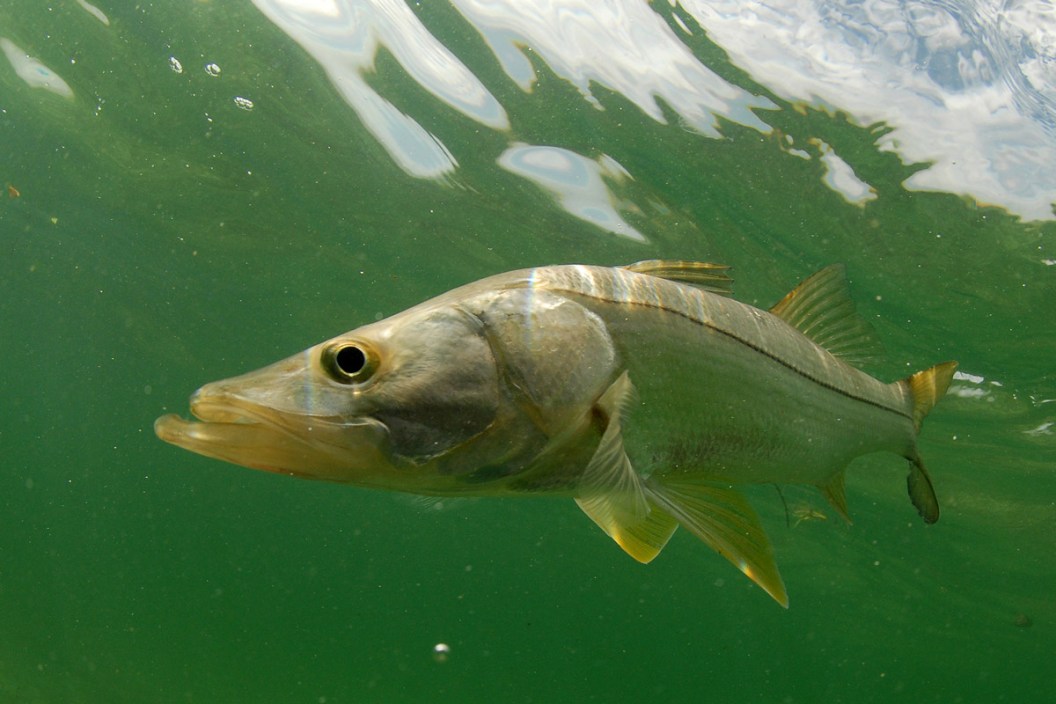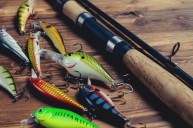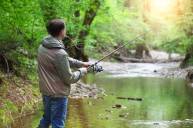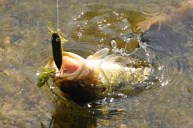While summer brings a rush of sun-burnt tourists and glistening locals to Florida's Gulf Coast beaches, the shallow waters just off those sandy shorelines host a major gathering of the state's premier inshore species: the pin-striped powerhouse known as snook. June through September sees mature "linesiders" moving through coastal passes and staging in the shallow surf where they'll spawn on the swifter tides around new and full moons. Between these periods of heavy water flow, the fish will scatter along the beaches, where wading the water's edge offers sight fishing opportunities with live bait, light lures or flies.
No question, the beach bite can be tons of fun and the summer spawn definitely increases your chances of encountering a straight-up trophy. However, significant opportunities await throughout the snook's summer course, so learn the hotspots, make the right presentations and you'll experience one of the most exciting predators in southern waters.
Where to Find Them

Getty: Bruskov
The consummate ambush predator, snook are a cover-oriented fish, so think in terms of where they can position to intercept prey passing on the tide. Bulking up for the summer spawn, the fish will feed aggressively, especially during the cooler, low-light conditions of mornings and afternoons.
One of the most consistent scenarios is a mangrove edge. Be it mainland or island, the tangle of emergent roots offers plenty of hidey holes, while overhanging limbs provide strategic shade lines. Depth variances play a key role here, so consider where the strength of daily tides hit the mangrove edges. This natural flow will carve our trenches and holes where snook can belly down and pick off tide-borne meals. Island tips often have distinct troughs where snook feed with ease. Oyster bars and shallow rock outcroppings also attract snook, as their tidal breaks create comfortable slack water zones. The same goes for bridge pilings and docks, or anything that blocks the current can serve the snook's purpose.
Sidenote: After sundown, dock, bridge or pier lights offer insane action, as snook use the shadow lines to target shrimp, crabs and baitfish. Toss a live bait or lure up-current, keep it high in the water column and drift it through the strike zone.
What They Like

Getty: passion4nature
When the water's relatively clear, live shrimp, scaled sardines (aka "whitebait" or "pilchard") and threadfin herring ("greenbacks") deliver consistency. Most hook shrimp under the horn, while baitfish rigging's more situational. In swifter current, hook them through the snout for a more natural swimming posture. For slack water spots, or slower current, hide the hook below your bait by setting it through the soft pocket behind the pectoral (side) fins. In murkier water and/or dimmer sky conditions, the noisier pinfish or pigfish (grass grunt) gets more attention. Lip or tail hooking is common for these baits.
Snook feed best on moving tides, but don't throw in the towel during slack water periods. Dead baits soaked in deep potholes, island troughs and near bridge pilings often find hungry takers. You'll weed through some catfish and stingrays, but slack tide snook can be surprisingly responsive.
On the artificial side, there's no greater excitement that seeing a snook blast a topwater. Walking baits like the Saltwater Zara Spook or Rapala Skitterwalk fished around shoreline snags, mangrove edges, docks, and seawalls will deliver a show. Bucktails and lead-head jigs with paddle tails also produce, as do suspending or slow sinking twitchbaits like the MirrOlure MirrODine. One of the most consistent subsurface artificials is an artificial shrimp like the original DOA or a LIVETARGET Rigged Shrimp.
If You Chum, They Will Come
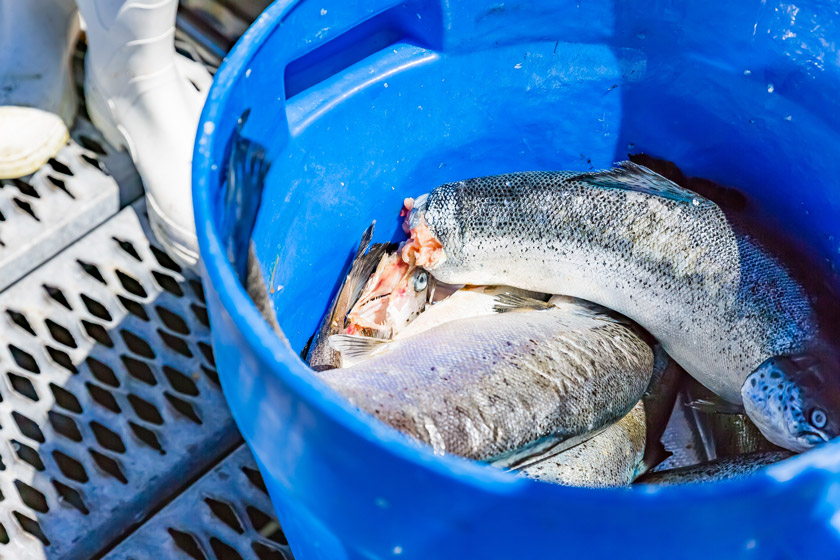
Getty: Taku_S
When the fish are on, they need no coaxing; but live chumming can jumpstart the bite on a slow tide stage, or regenerate some interest after a flurry of activity. If nothing else, the violent pops of snook smacking vulnerable freebies will direct your casts. Tossing a handful of live baits works, but avoid the arm strain by using a "chum bat"—a plastic ball bat form with a broad body and an open tip. Load a dozen or so livies, give 'em a shake to disorient them and make an easy, efficient toss toward the target zone.
A couple things to consider: Throw your chum at or up-tide of the are you're fishing. Throw them too far downtide and the moving water carries the appetizers and the fish out of your range. Also, don't overdo it. Chum 'til they're fired up, not filled up.
Tackle for the Task
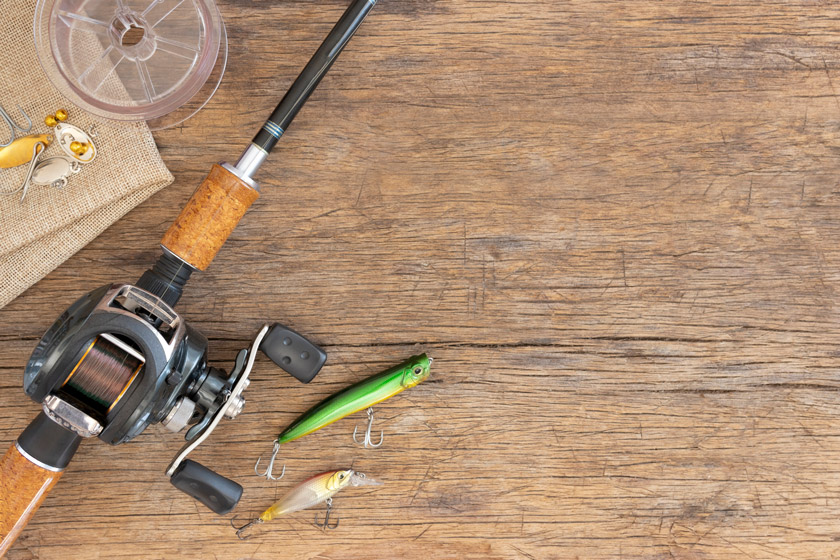
Getty: Longmongdoosi
Experienced anglers appreciate the efficiency of baitcasting gear, but a 7-3 to 7-6 medium heavy spinning outfit will handle most of the snook you encounter. Spool up with 30- to 50-pound braided main line and tie 3 feet of 30-pound fluorocarbon leader. Anglers targeting true giants in the 20-pound plus range with huge live baits often break out the beefy conventional outfits.
For live baits, a 2/0-3/0 circle hook is best. J-hooks will suffice, but modern live baiters achieve more consistent connections with virtually no risk of deep hooking fish on circle hooks. When a snook bites down, the inward facing point rotates forward to grab the fish near the front of the mouth. You just have to eliminate the hook set. On the bite, just reel down to the fish and come tight. "Setting" a circle hook will pull it out of the fish's mouth, while patient, smooth pressure pulls it home.
To protect snook during their vulnerable spawning season, the state closes the harvest May 1-Aug. 31 on the Gulf Coast, Monroe County, and Everglades National Park (June 1-Aug. 31 on the Atlantic Coast). Released snook are often targeted by dolphins and sharks, so give them the best chance at avoiding trouble by holding them at boatside until they recharge their batteries. That sturdy bottom lip makes a natural gripping point and you'll know when the fish is ready to go when it clamps down on your thumb. Give the snook a little parting scoot and watch it swim off to fight another day.
